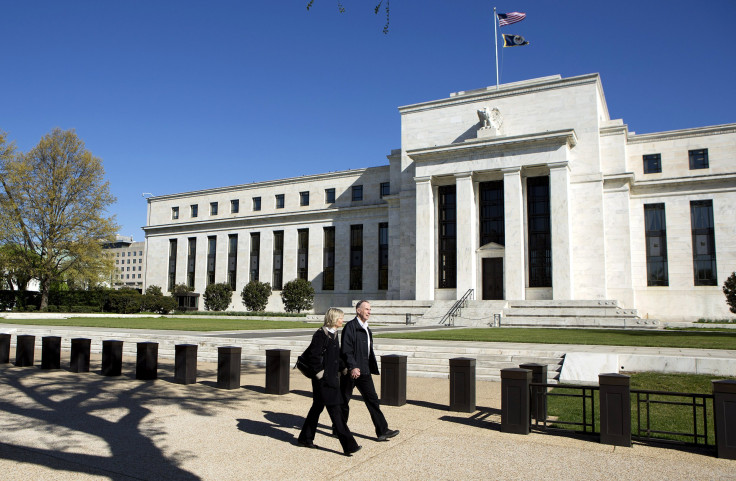October FOMC Preview: Fed Won’t Reduce Stimulus QE At This Week’s Meeting

The two-week partial federal government shutdown did not just delay major data releases and trim several tenths of a percent from expected fourth-quarter economic growth, it is also likely to keep the Federal Reserve from trimming its $85-billion-a-month bond purchase program this year.
“We expect no tapering and no changes to forward guidance" at this week’s meeting, Michael Hanson, senior U.S. economist for Bank of America, wrote in a note to clients. “However, both of these policy tools are likely to be discussed at length at this meeting, making the minutes of particular interest.”
The Federal Open Market Committee’s meeting starts Tuesday. A statement will be released at its conclusion around 2 p.m. EDT Wednesday. There are no forecast updates or a press conference planned for this meeting, so markets are likely to hang on every shift in wording in the statement. Markets will be especially focused on the discussion around the timing and conditions of tapering.
In June, when Chairman Ben Bernanke laid out a “framework” for starting to taper “later this year” and concluding asset purchases around mid-2014, Fed officials were still quite optimistic about the outlook. So too were consensus forecasts. Although the Fed’s ”framework” for tapering was conditional on their forecasts being realized, markets still continued to price in a September taper even after the data started to weaken notably in July and August.
But the combination of disappointing data, heightened fiscal policy uncertainty and the markets pricing in a much earlier start to the Fed’s tightening cycle than they had been signaling -- thus leading to tighter-than-desired financial conditions from the Fed’s perspective -- led the FOMC at its last meeting to postpone tapering until there was “more evidence that progress would be sustained.”
The changeover at the top of the Fed could also be a factor, Paul Ashworth of Capital Economics pointed out. The late January FOMC meeting is Bernanke's last as chair, while the mid-March meeting should be Janet Yellen's first (assuming her Senate confirmation).
Societe Generale now puts the odds of a December tapering announcement at 5 percent, January at 30 percent and March at 60 percent.
Goldman economists Jan Hatzius and Sven Jari Stehn expect only two small changes to the outlook paragraph in this week’s FOMC statement. First, the committee would probably want to acknowledge the softer labor market data. For example, the committee could state that labor market indicators have improved only “on balance.” Second, the statement might reflect the uncertainty introduced by the government shutdown and debt ceiling fight. For example, the committee could add that “the recent fiscal debates have raised uncertainty around the near-term outlook” to its statement that fiscal policy is restraining growth.
A Data-Dependent Fed
The Fed’s decision to hold off on tapering last month caught the markets by surprise. As a result, most predictions are now well into 2014, with the majority calling for a March taper.
“The decision not to taper in September was the right one in retrospect,” Aneta Markowska, chief U.S. economist at Societe Generale, said in a note.
Hanson suggested that market participants give most attention to whether the economy can obtain and maintain the “tolerable twos”: upper 2 percent gross domestic product growth rates, closer to a sustained 200,000 jobs per month pace of payroll growth and inflation starting to converge back toward the Fed’s longer-term 2 percent objective.
For the past year, inflation as measured by the core PCE deflator has generally been below 1.5 percent. It has been between 1.1 percent and 1.2 percent for the past five months.
“For a ‘data-dependent’ Fed, these are the conditions most relevant to determining when tapering will begin,” Hanson said.
Recent employment growth has been disappointing, with a lower-than-expected 148,000 nonfarm jobs created in September and minimal net revisions to prior months. As a result, the six-month moving average barely budged, and stands at 163,000. That is well below the 200,000-plus average seen in the spring and barely higher than the pace a year ago, which prompted the Fed to resume its asset purchases in the first place.
October's employment figures, to be released on Nov. 8, will presumably show a negative effect from the shutdown and even if they don't, the reliability of the estimates will be questionable thanks to the shutdown's effect had on the payroll survey.
The Potential Cost of QEternity
QE3 is now on track to be the largest bond-buying program yet -- bigger than QE1, which totaled $1.5 trillion. The second round of stimulus added up to about $600 billion.
QE3 has already resulted in a near $1 trillion cumulative increase in the monetary base, and if QE3 continues at its current pace until next March, and is then followed by a relatively brief six-month tapering period, its overall size would end up being around $1.6 trillion.
The Fed's asset holdings are already in excess of $3.5 trillion and will reach a peak of about $4.2 trillion.
“There is a danger that the Fed has missed its window of opportunity,” Ashworth said. “If it's waiting for some degree of fiscal certainty, this really could turn into QEternity.”
“If the Fed begins the tapering later, it could always wind down its purchases more quickly than it originally envisaged. But we suspect it would probably still want to spread the tapering over at least six months,” Ashworth said.
“That raises the risk that the Fed will eventually be forced to sell assets at a capital loss,” he added.
© Copyright IBTimes 2025. All rights reserved.






















